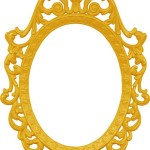New Words For Mirror Image
The concept of a "mirror image" is fundamental across various disciplines, including mathematics, physics, art, and computer science. While the term itself is widely understood, the nuances of reflection and symmetry that it represents can often benefit from more precise and context-specific vocabulary. Expanding the lexicon surrounding this concept allows for a more refined understanding and application in specialized fields. This article explores alternative terms and concepts related to mirror images, focusing on their specific connotations and applications.
The term "mirror image" inherently implies a reversal along a single axis. However, real-world reflections are often more complex, involving rotations, distortions, and multiple reflections. Therefore, a richer vocabulary is needed to accurately describe these diverse phenomena. Exploring terms that emphasize specific aspects of reflection can improve communication and problem-solving in areas such as optics, crystallography, and even psychology.
Symmetry and its Subtypes
The concept of symmetry is intrinsically linked to mirror images. A shape possesses symmetry when it can be transformed without changing its overall appearance. There are several types of symmetry, each representing a different kind of invariance under transformation. Understanding these different types of symmetry allows for a more nuanced representation of the properties usually associated with mirror images and reflections.
Reflection Symmetry (Bilateral Symmetry):
This is arguably the most direct synonym for a mirror image. Reflection symmetry, also known as bilateral symmetry, describes an object that can be divided into two identical halves by a plane. Each half is a mirror image of the other. Many biological organisms, including humans, exhibit bilateral symmetry. The term highlights the specific plane along which the reflection occurs, emphasizing the axis of symmetry.Rotational Symmetry:
Although not a direct mirror image, rotational symmetry relates to the concept of invariance under rotation. An object has rotational symmetry if it appears the same after being rotated by a certain angle. While it doesn't involve a reflection, it does share the underlying principle of self-similarity and transformation without changing the fundamental form.Translational Symmetry:
This type of symmetry exists when an object or pattern remains unchanged after being translated (moved) in a particular direction. This is often seen in repeating patterns like those found in wallpaper or tiled floors. Like rotational symmetry, it highlights the broader concept of invariance under transformation, which is a characteristic feature also found in objects with mirror symmetry.Glide Reflection Symmetry:
This symmetry combines reflection and translation. An object with glide reflection symmetry is reflected across a line and then translated along that same line. Footprints in the sand often exhibit glide reflection symmetry. This term offers a more complex description than a simple mirror image, highlighting the combination of two distinct transformations.The careful use of these subtypes of symmetry allows for describing complex structures and relationships that a simple “mirror image” designation does not encompass. In fields such as crystallography, where the arrangement of atoms in a crystal lattice dictates material properties, defining the exact form of symmetry is critical.
Chirality and Enantiomers
Chirality refers to a property of asymmetry where an object is non-superimposable on its mirror image. This concept is particularly important in chemistry, where it describes molecules that exist in two forms (enantiomers) that are mirror images of each other but cannot be superimposed, much like a left and right hand. These molecules often exhibit different biological activities.
Enantiomer:
This term specifically denotes one of two chiral molecules that are mirror images of each other. Enantiomers have identical physical properties, such as melting point and boiling point, but they rotate plane-polarized light in opposite directions. This difference in optical activity is a key characteristic for distinguishing between enantiomers. The term is specific to chemical compounds exhibiting this mirror-image property.Stereoisomer:
This is a broader term that encompasses enantiomers as well as other isomers that have the same molecular formula and sequence of bonded atoms (constitution), but differ in the three-dimensional orientations of their atoms in space. It is a general term for molecules that differ only in the spatial arrangement of their atoms.Asymmetric Carbon (Chiral Center):
This term specifically refers to an atom (usually carbon) that is bonded to four different atoms or groups of atoms. The presence of an asymmetric carbon atom is a common cause of chirality in molecules. Identifying chiral centers is essential for determining whether a molecule can exist as enantiomers.The significance of chirality extends beyond chemistry, with implications in pharmacology, where different enantiomers of a drug can have vastly different effects on the body. The careful control of enantiomeric purity is crucial in drug development and manufacturing. Terms like "enantiomer" and "chiral center" provide the necessary vocabulary to describe and manipulate these subtle but critical distinctions.
Transformations and Mapping
In mathematics and computer graphics, mirror images are often described in terms of transformations. A transformation is a function that maps a point in space to another point. Several types of transformations are relevant to the concept of mirror images.
Reflection Transformation:
This transformation reflects a point across a line (in 2D) or a plane (in 3D). The resulting point is the mirror image of the original point with respect to the line or plane of reflection. This is a precise mathematical definition of the process of creating a mirror image.Inversion:
This transformation maps a point to another point along a line passing through a fixed point (the center of inversion) such that the product of the distances from the center of inversion to the original point and the image point is constant. While not a direct mirror image in the traditional sense, inversion creates a geometrically related image with specific properties.Homothety (Dilation):
This transformation scales an object with respect to a fixed point (the center of homothety). If the scaling factor is negative, the resulting image is inverted and can be considered a type of mirror image with respect to the center of homothety. Homothety offers a way to generate images that are similar to mirror images but with different size and orientation.Isometric Transformation:
This is a more general term that describes transformations that preserve distances. Reflection is an example of an isometric transformation. When analyzing geometric objects and their transformations, "isometric transformation" can be useful in defining the specific ways their spatial relationship has changed.Using the language of transformations provides a mathematically rigorous way to describe and manipulate mirror images. In computer graphics, reflections are implemented using reflection transformations, allowing for the creation of realistic images and animations.
These alternative terms and related concepts provide a richer and more nuanced understanding of the idea of a "mirror image." Depending on the specific context, using terms like "bilateral symmetry," "enantiomer," or "reflection transformation" can communicate more precise information than the general term "mirror image." This expanded vocabulary allows for a more sophisticated analysis and application of the principles of reflection across diverse scientific and artistic disciplines.
In summary, while "mirror image" serves as a universally understood term, deeper explorations into its core characteristics reveal specialized vocabulary that can offer more precision and context. Symmetry types, such as reflection, rotational, translational, and glide reflection symmetries, delve into the invariance principles. Terms such as enantiomer and chiral center provide specific chemical applications. Mathematical transformations such as reflection, homothety, and isometry offer a more rigorous and precise way to represent and manipulate mirror images. These expansions offer a broadened perspective in different scientific and artistic disciplines.

Mirror Image Synonyms 1 702 Words And Phrases For

86 Mirror Selfie Captions For Instagram Pictures 2024

How To Mirror Write 7 Steps With Pictures Wikihow

New Zealand Sight Words Mystery Mirror

Positive Affirmation Mirror Set Elementary Classroom Decor Goals New

Instagram Captions For Selfie 170 Best Cool Stylish Mirror Selfies 91mobiles Com

Custom Words Mirror Gold Acrylic Sayings Sign Letters Name With Quotes Personalised New Zealand

How To Make Mirror Image Text In Microsoft Word It All Started With Paint Words

Bending Words Advanced Rhyming Techniques In Rap Colemizestudios

Mirror Words Whole Brain Teaching








